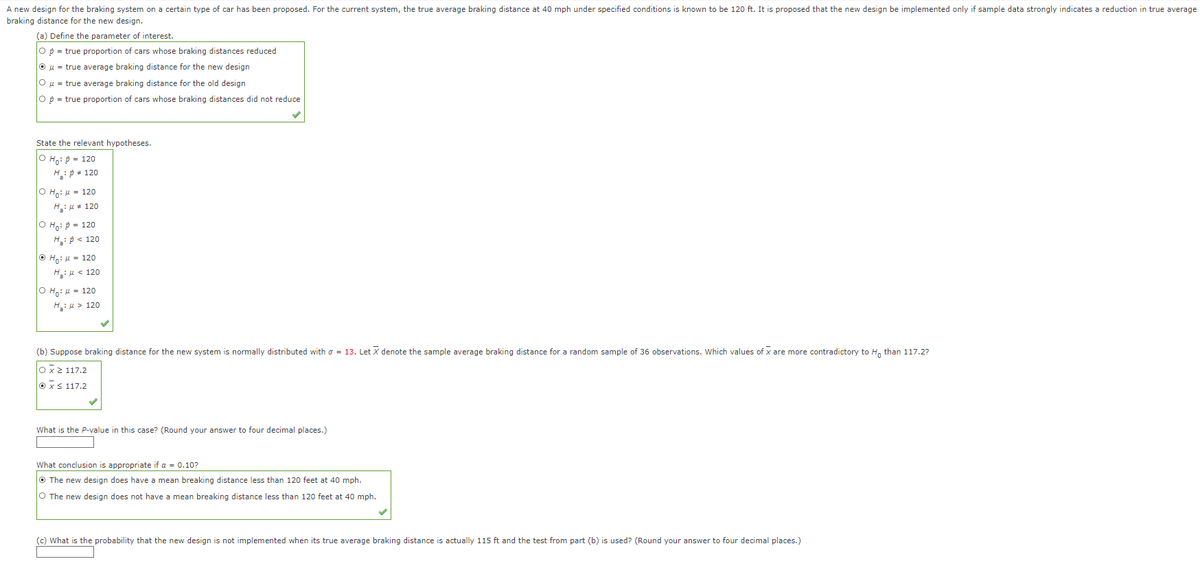A new design for the braking system on a certain type of car has been proposed. For the current system, the true average braking distance at 40 mph under specified conditions is known to be 120 ft. It is proposed that the new design be implemented only if sample data strongly indicates a reduction in tru braking distance for the new design. (a) Define the parameter of interest. Op=true proportion of cars whose braking distances reduced - true average braking distance for the new design O=true average braking distance for the old design Op=true proportion of cars whose braking distances did not reduce State the relevant hypotheses. OH: P-120 M₂: P-120 OH:120 M₁R 120 OHP-120 H₂: <120 ⒸH₂-120 M₂: 120 ⒸH₂-120 M₂: 120 (b) Suppose braking distance for the new system is normally distributed with 13. Let X denote the sample average braking distance for a random sample of 36 observations. Which values of x are more contradictory to Ho than 117.2? 0x2 117.2 exs 117.2 What is the P-value in this case? (Round your answer to four decimal places.) What conclusion is appropriate if a 0.10? The new design does have a mean breaking distance less than 120 feet at 40 mph. The new design does not have a mean breaking distance less than 120 feet at 40 mph.
A new design for the braking system on a certain type of car has been proposed. For the current system, the true average braking distance at 40 mph under specified conditions is known to be 120 ft. It is proposed that the new design be implemented only if sample data strongly indicates a reduction in tru braking distance for the new design. (a) Define the parameter of interest. Op=true proportion of cars whose braking distances reduced - true average braking distance for the new design O=true average braking distance for the old design Op=true proportion of cars whose braking distances did not reduce State the relevant hypotheses. OH: P-120 M₂: P-120 OH:120 M₁R 120 OHP-120 H₂: <120 ⒸH₂-120 M₂: 120 ⒸH₂-120 M₂: 120 (b) Suppose braking distance for the new system is normally distributed with 13. Let X denote the sample average braking distance for a random sample of 36 observations. Which values of x are more contradictory to Ho than 117.2? 0x2 117.2 exs 117.2 What is the P-value in this case? (Round your answer to four decimal places.) What conclusion is appropriate if a 0.10? The new design does have a mean breaking distance less than 120 feet at 40 mph. The new design does not have a mean breaking distance less than 120 feet at 40 mph.
MATLAB: An Introduction with Applications
6th Edition
ISBN:9781119256830
Author:Amos Gilat
Publisher:Amos Gilat
Chapter1: Starting With Matlab
Section: Chapter Questions
Problem 1P
Related questions
Question
Q5. Please only answer the fill-ins

Transcribed Image Text:A new design for the braking system on a certain type of car has been proposed. For the current system, the true average braking distance at 40 mph under specified conditions is known to be 120 ft. It is proposed that the new design be implemented only if sample data strongly indicates a reduction in true average
braking distance for the new design.
(a) Define the parameter of interest.
O p = true proportion of cars whose braking distances reduced
Ⓒ μ = true average braking distance for the new design
O μ = true average braking distance for the old design
Op = true proportion of cars whose braking distances did not reduce
State the relevant hypotheses.
O Ho: p = 120
H₂: p * 120
O Ho: μ = 120
H₂:μ* 120
O Ho: P = 120
H₂: P < 120
ⒸHo: μ = 120
H₂: μ< 120
O Ho: μ = 120
H₂: > 120
(b) Suppose braking distance for the new system is normally distributed with = 13. Let X denote the sample average braking distance for a random sample of 36 observations. Which values of x are more contradictory to H. than 117.2?
O x 2 117.2
Ox≤ 117.2
What is the P-value in this case? (Round your answer to four decimal places.)
What conclusion is appropriate if a = 0.10?
The new design does have a mean breaking distance less than 120 feet at 40 mph.
O The new design does not have a mean breaking distance less than 120 feet at 40 mph.
(c) What is the probability that the new design is not implemented when its true average braking distance is actually 115 ft and the test from part (b) is used? (Round your answer to four decimal places.)
Expert Solution
This question has been solved!
Explore an expertly crafted, step-by-step solution for a thorough understanding of key concepts.
Step by step
Solved in 3 steps with 1 images

Recommended textbooks for you

MATLAB: An Introduction with Applications
Statistics
ISBN:
9781119256830
Author:
Amos Gilat
Publisher:
John Wiley & Sons Inc

Probability and Statistics for Engineering and th…
Statistics
ISBN:
9781305251809
Author:
Jay L. Devore
Publisher:
Cengage Learning

Statistics for The Behavioral Sciences (MindTap C…
Statistics
ISBN:
9781305504912
Author:
Frederick J Gravetter, Larry B. Wallnau
Publisher:
Cengage Learning

MATLAB: An Introduction with Applications
Statistics
ISBN:
9781119256830
Author:
Amos Gilat
Publisher:
John Wiley & Sons Inc

Probability and Statistics for Engineering and th…
Statistics
ISBN:
9781305251809
Author:
Jay L. Devore
Publisher:
Cengage Learning

Statistics for The Behavioral Sciences (MindTap C…
Statistics
ISBN:
9781305504912
Author:
Frederick J Gravetter, Larry B. Wallnau
Publisher:
Cengage Learning

Elementary Statistics: Picturing the World (7th E…
Statistics
ISBN:
9780134683416
Author:
Ron Larson, Betsy Farber
Publisher:
PEARSON

The Basic Practice of Statistics
Statistics
ISBN:
9781319042578
Author:
David S. Moore, William I. Notz, Michael A. Fligner
Publisher:
W. H. Freeman

Introduction to the Practice of Statistics
Statistics
ISBN:
9781319013387
Author:
David S. Moore, George P. McCabe, Bruce A. Craig
Publisher:
W. H. Freeman